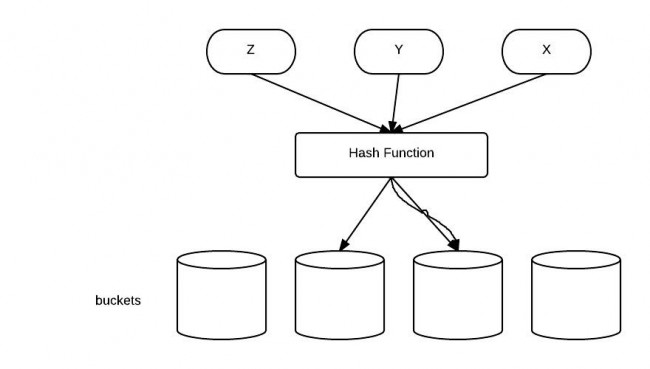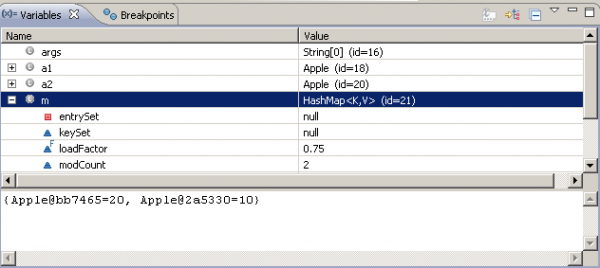java对象equals方法的重写
根类Object中的equals方法描述:
public boolean equals(Object obj)
Theequalsmethod for classObjectimplements the most discriminating possible equivalence relation on objects; that is, for any non-null reference valuesxandy, this method returnstrueif and only ifxandyrefer to the same object (x == yhas the valuetrue).
String类重写了equals方法:
public boolean equals(Object anObject)
Compares this string to the specified object. The result istrueif and only if the argument is notnulland is aStringobject that represents the same sequence of characters as this object
1.基本数据类型,也称原始数据类型。byte,short,char,int,long,float,double,boolean
他们之间的比较,应用双等号(==),比较的是他们的值。
2.复合数据类型(类)
当他们用(==)进行比较的时候,比较的是他们在内存中的存放地址,所以,除非是同一个new出来的对象,他们的比较后的结果为true,否则比较后结果为false。 JAVA当中所有的类都是继承于Object这个基类的,在Object中的基类中定义了一个equals的方法,这个方法的初始行为是比较对象的内存地址(即引用里的内容),但在一些类库当中这个方法被覆盖掉了,如String,Integer,Date在这些类当中equals有其自身的实现,而不再是比较类在堆内存中的存放地址了。
对于复合数据类型之间进行equals比较,在没有覆写equals方法的情况下,他们之间的比较还是基于他们在内存中的存放位置的地址值的,因为Object的equals方法也是用双等号(==)进行比较的,所以比较后的结果跟双等号(==)的结果相同。
public boolean equals(Object obj) { if(obj == null) return false; //keep the object compared not be null else{ if(obj instanceof Cat) //keep the object input be Cat { Cat c = (Cat) obj; //Cast to Cat if(c.color == this.color&& c.height == this.hright) { return true; } } } return false; }
hashCode method whenever this method is overridden, so as to maintain the general contract for the hashCode method, which states that equal objects must have equal hash codes.
1 package com.zj.unit; 2 import java.util.Arrays; 3 4 public class Unit { 5 private short ashort; 6 private char achar; 7 private byte abyte; 8 private boolean abool; 9 private long along; 10 private float afloat; 11 private double adouble; 12 private Unit aObject; 13 private int[] ints; 14 private Unit[] units; 15 16 public boolean equals(Object o) { 17 if (!(o instanceof Unit)) 18 return false; 19 Unit unit = (Unit) o; 20 return unit.ashort == ashort 21 && unit.achar == achar 22 && unit.abyte == abyte 23 && unit.abool == abool 24 && unit.along == along 25 && Float.floatToIntBits(unit.afloat) == Float 26 .floatToIntBits(afloat) 27 && Double.doubleToLongBits(unit.adouble) == Double 28 .doubleToLongBits(adouble) 29 && unit.aObject.equals(aObject) 30 && equalsInts(unit.ints) 31 && equalsUnits(unit.units); 32 } 33 34 private boolean equalsInts(int[] aints) { 35 return Arrays.equals(ints, aints); 36 } 37 38 private boolean equalsUnits(Unit[] aUnits) { 39 return Arrays.equals(units, aUnits); 40 } 41 42 public int hashCode() { 43 int result = 17; 44 result = 37 * result + (int) ashort; 45 result = 37 * result + (int) achar; 46 result = 37 * result + (int) abyte; 47 result = 37 * result + (abool ? 0 : 1); 48 result = 37 * result + (int) (along ^ (along >>> 32)); 49 result = 37 * result + Float.floatToIntBits(afloat); 50 long tolong = Double.doubleToLongBits(adouble); 51 result = 37 * result + (int) (tolong ^ (tolong >>> 32)); 52 result = 37 * result + aObject.hashCode(); 53 result = 37 * result + intsHashCode(ints); 54 result = 37 * result + unitsHashCode(units); 55 return result; 56 } 57 58 private int intsHashCode(int[] aints) { 59 int result = 17; 60 for (int i = 0; i < aints.length; i++) 61 result = 37 * result + aints[i]; 62 return result; 63 } 64 65 private int unitsHashCode(Unit[] aUnits) { 66 int result = 17; 67 for (int i = 0; i < aUnits.length; i++) 68 result = 37 * result + aUnits[i].hashCode(); 69 return result; 70 } 71 }
关键是如何计算hashcode值.
此外要注意如何在Java中避免equals方法的隐藏陷阱(http://coolshell.cn/articles/1051.html)
下面给出比较成熟的equals()代码:
1 public boolean equals(Object obj) 2 { 3 if(this == obj) 4 { 5 return true; 6 } 7 if(obj != null && obj.getClass() == Person.class) 8 { 9 Person personObj = (Person) obj; 10 if(this.getldStr().equals(personObj.getldStr())) 11 { 12 return true; 13 } 14 } 15 16 return false; 17 }
忠告:1、覆盖equals时总要覆盖hashcode; 2、Don’t try to be too clever不要试图让equals方法过于智能; 3、Don’t substitute another type for Object in the equals declaration.不要将equals声明中Object对象替换为其他对象
public boolean equals(MyClass o) {
...
}需使用Object o
附转载:http://www.importnew.com/8701.html 或 http://www.programcreek.com/2011/07/java-equals-and-hashcode-contract/

The Java super class java.lang.Object has two very important methods defined:
public boolean equals(Object obj) public int hashCode() |
They have been proved to be extremely important to understand, especially when user-defined objects are added to Maps. However, even advanced-level developers sometimes can’t figure out how they should be used properly. In this post, I will first show an example of a common mistake, and then explain how equals() and hashCode contract works.
1. A common mistake
Common mistake is shown in the example below.
import java.util.HashMap; public class Apple { private String color; public Apple(String color) { this.color = color; } public boolean equals(Object obj) { if (!(obj instanceof Apple)) return false; if (obj == this) return true; return this.color.equals(((Apple) obj).color); } public static void main(String[] args) { Apple a1 = new Apple("green"); Apple a2 = new Apple("red"); //hashMap stores apple type and its quantity HashMap<Apple, Integer> m = new HashMap<Apple, Integer>(); m.put(a1, 10); m.put(a2, 20); System.out.println(m.get(new Apple("green"))); } } |
In this example, a green apple object is stored successfully in a hashMap, but when the map is asked to retrieve this object, the apple object is not found. The program above prints null. However, we can be sure that the object is stored in the hashMap by inspecting in the debugger:

2. Problem caused by hashCode()
The problem is caused by the un-overridden method “hashCode()”. The contract between equals() and hasCode() is that:
1. If two objects are equal, then they must have the same hash code.
2. If two objects have the same hashcode, they may or may not be equal.
The idea behind a Map is to be able to find an object faster than a linear search. Using hashed keys to locate objects is a two-step process. Internally the Map stores objects as an array of arrays. The index for the first array is the hashcode() value of the key. This locates the second array which is searched linearly by using equals() to determine if the object is found.
The default implementation of hashCode() in Object class returns distinct integers for different objects. Therefore, in the example above, different objects(even with same type) have different hashCode.
Hash Code is like a sequence of garages for storage, different stuff can be stored in different garages. It is more efficient if you organize stuff to different place instead of the same garage. So it’s a good practice to equally distribute the hashCode value. (Not the main point here though)
The solution is to add hashCode method to the class. Here I just use the color string’s length for demonstration.
public int hashCode(){ return this.color.length(); } |



